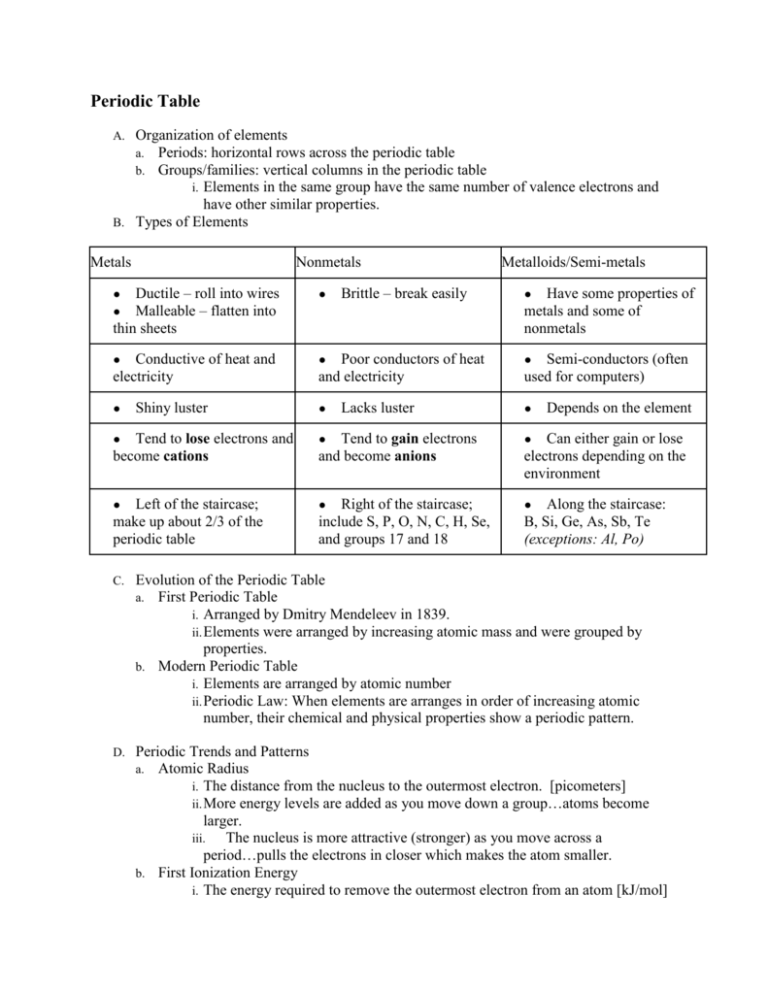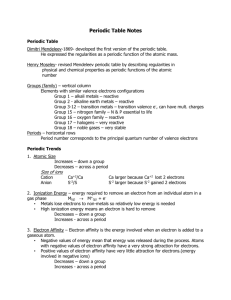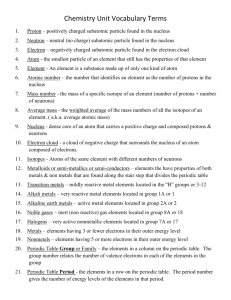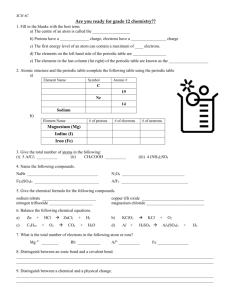Cheat Sheet * Periodic Table
advertisement

Periodic Table Organization of elements a. Periods: horizontal rows across the periodic table b. Groups/families: vertical columns in the periodic table i. Elements in the same group have the same number of valence electrons and have other similar properties. B. Types of Elements A. Metals Nonmetals ● ● Ductile – roll into wires Malleable – flatten into thin sheets ● ● Conductive of heat and electricity ● ● Shiny luster Metalloids/Semi-metals Brittle – break easily ● Poor conductors of heat and electricity ● ● ● Lacks luster Have some properties of metals and some of nonmetals Semi-conductors (often used for computers) ● Tend to lose electrons and become cations ● Tend to gain electrons and become anions ● ● ● ● Left of the staircase; make up about 2/3 of the periodic table Right of the staircase; include S, P, O, N, C, H, Se, and groups 17 and 18 Depends on the element Can either gain or lose electrons depending on the environment Along the staircase: B, Si, Ge, As, Sb, Te (exceptions: Al, Po) C. Evolution of the Periodic Table a. First Periodic Table i. Arranged by Dmitry Mendeleev in 1839. ii. Elements were arranged by increasing atomic mass and were grouped by properties. b. Modern Periodic Table i. Elements are arranged by atomic number ii. Periodic Law: When elements are arranges in order of increasing atomic number, their chemical and physical properties show a periodic pattern. D. Periodic Trends and Patterns a. Atomic Radius i. The distance from the nucleus to the outermost electron. [picometers] ii. More energy levels are added as you move down a group…atoms become larger. iii. The nucleus is more attractive (stronger) as you move across a period…pulls the electrons in closer which makes the atom smaller. b. First Ionization Energy i. The energy required to remove the outermost electron from an atom [kJ/mol] ii. Smaller atoms hold their electrons tighter which make them harder to remove. iii. Larger atoms have a loose grip on their electrons, making them easier to remove. c. Electronegativity i. The ability of an atom to attract electrons in a chemical bond. [no units] ii. Noble gases do not have an electronegativity value; they will not bond with anything. iii. Small atoms have strong nuclei, which can attract electrons towards themselves. iv. Large atoms have weaker nuclei, which cannot attract electrons towards themselves. d. Electron Affinity i. The amount of energy released when an atom gains an electron. [kJ/mol] ii. Chlorine has the greatest electron affinity. e. Ionic Radius i. The radius of a cation or anion. [picometers] ii. Cations (lose electrons) become smaller. iii. Anions (gain electrons) become bigger. Specific Group Properties E. Group # Name Appearance Valance e- Reactivity Phase(s) 1 Alkali Very soft, shiny metals 1 Most reactive metals Solids 2 Alkali Earth Soft, shiny metals 2 Moderately Reactive Solids 3-12 Transition Strong, shiny metals Varied Somewhat reactive Solids 17 Halogens Hard, shiny 7 18 Noble Gases All are gases 8 Most reactive nonmetals All phases Not reactive (inert) Most Reactive Metal (Francium–Fr) i. Large atom, low ionization energy, low electronegativity b. Most Reactive Nonmetal (Fluorine–F) i. Small atom, high ionization energy, high electronegativity a. Gases






